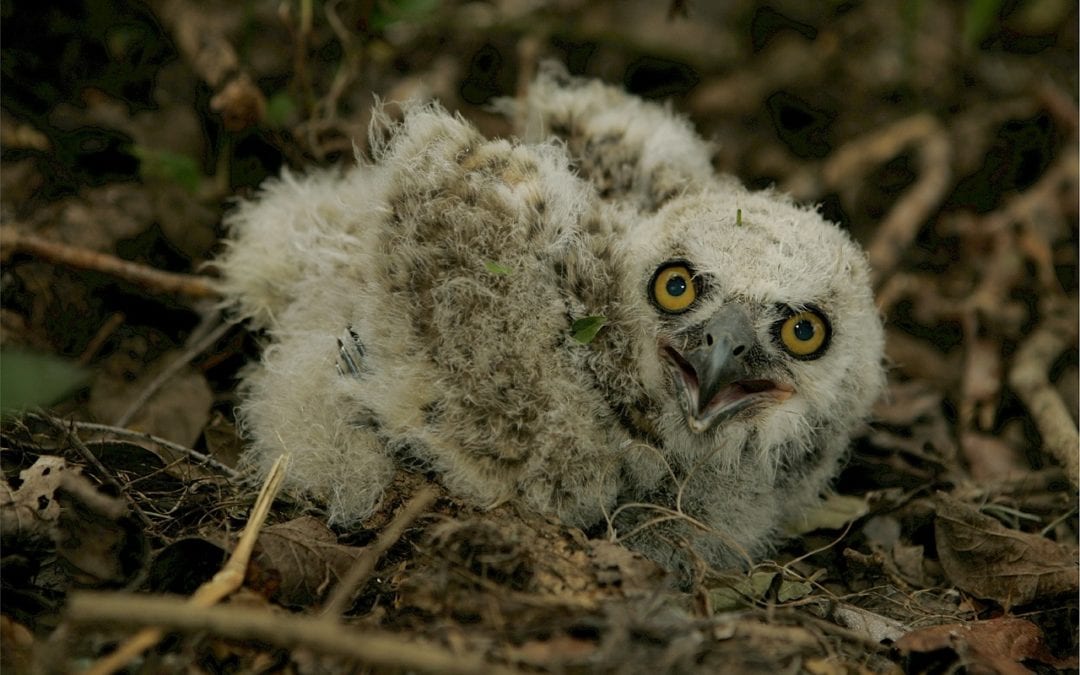Owls and some other animals spend a short period of time imprinting. This is where they figure out that whoever they are with are the ones they are supposed to grow up to be like and eventually pair bond and mate with. Dictionary dot com lists it as “rapid learning that occurs during a brief receptive period, typically soon after birth or hatching, and establishes a long-lasting behavioral response to a specific individual or object, as attachment to parent, offspring, or site.”
Horses do it within about six hours of birth. Geese imprint between 13 and 16 hours after hatching. Dogs imprint between six and twelve weeks. Deer in the first few months and raptors in the first three weeks. It is the period of time that babies learn what they are to be like.
(There were two movies made about geese imprinting on humans Winged Migration and Fly Away Home. Both took geese and used imprinting to teach them to migrate. The ultralight flew south and they migrated.)
Raptors (hawks and owls) imprint in a few weeks after birth. If they imprint on humans, they identify with humans for life. This is not a good thing. The lack of fear of humans means that they can be aggressive or territorial. A classmate runs marathons and has been attacked several times by a territorial barred owl. This owl was probably raised by humans and now does not fit in either world.
Human imprinted birds also do not relate well to their own species. They lack the vocalization, postures that are normally learned from their parents. Because they are odd and don’t “talk right” they are not accepted by their own species. That means they do not find mates or raise young.
It is not like they are friendly to humans either. They are not programmed to be around people or interact with them. By the way, an owl that “likes” being petted is very sick, blind or dying or being tremendously stressed by the act. Even imprinted owls find it stressful to interact within their personal space with humans.
Because we do wildlife rehab, we become involved when good Samaritans pick up the birds out of the nest or as branchers and don’t bring them in for a while.
This is bad. In the first place, it is illegal to take in an owl or hawk without a wildlife rehabilitation permit or a veterinary license. All people who take in raptors should have attended and passed the wildlife rehabilitation course. (I have attended this course twice and have been to several continuing education sessions over the years.)
Secondly, many hawks, owls and baby birds do not need to be taken out of the wild. Just like teens, baby birds don’t just wake up one day and fly away. The teen birds are called branchers and will fly and hop and practice flight for a few days or a couple of weeks. The bird parents will feed the babies out of the nest and where ever they have gotten to. Teens ask for the keys and expect there to be gas in it. Of course, sometimes, mom is dead, the tree is down, something is about to eat them or another danger and the babies do need to be brought in. (For song birds, nail a margarine container with drain holes punched in the bottom to a tree with bushes around as high as you can reach. The mom cannot smell you and will feed the complaining baby.)
Finally, care is complex. We have had owls brought in that were fed milk and berries. (They really eat mice, rats, snakes, and other prey.) Wounds that are not identified often have maggots and damage that could have been prevented. And imprinting is a huge problem. They should be handled as little as possible. We do not talk around baby birds. Sometimes we even wear masks or use puppets to feed babies.
Perhaps baby hawks are not as cute, but we have less problems with people keeping them. But hawks that are imprinted for falconry are taught to mate on human heads, sperm collected in special hats and then deposited in the females. Not something I would like to have happen on a walk in the woods. We wear hard hats in flight cages.
And that is the real problem. Birds who are human-imprinted are deemed unsuitable for release back into the wild due to these inappropriate interactions, but some people do it anyway.
A territorial owl that attacks joggers or a taloned hawk that is amorous is dangerous to humans. Humans then cry for the destruction of the animal species that hurt the human and it doesn’t matter that humans did the damage in the first place.
Normally we have an adult owl or a group of babies that they can grow up with. If we have a hit by car owl in the early spring that we know cannot be released and it is not too stressed by being here, we will keep the adult to raise a group of babies. Even a group that is raised together is less likely to be imprinted. This year, we do not have any adult owls and both of these owls were kept by the good samaritans for longer than they should have been. I hope they are not fully imprinted, but three people gave up a significant portion of their weekend to get these kids to be with other owls. It may be too late. If so, they may find a home as an education bird. Or they may have to be put to sleep. That is sad. And totally preventable. That is frustrating.
We do wildlife rehabilitation for free as a community service. We cannot take in all animals and we do accept donations. We really do care about all animals.

